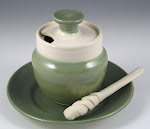I was fresh out of elves the last 9 or 10 days, while I've been down with bronchitis. This stupidly debilitating illness has become a recurring issue over several years, and turns out to be more like asthma now. Finally diagnosed, I have a new medicine regimen that should keep it at bay. I look forward to being in the studio and taking care of business on all levels on a regular basis again by the middle of next week, having healed sufficiently and passed through seasonal and family events.
As a side note, I have ordered a quadruple-filter air cleaner unit for my studio, which should help me stay healthy despite the dust-producing materials of my job.
While I was down and out for the count, all I could muster energy for was sketching. Thinking about Judaica, I sketched variations of a havdalah set design. This would be comprised of a stemless goblet, candleholder and spice box with stopper, on a curvy tray made just to fit them together, an item used in a series of blessings that usher out the Sabbath. The design is coming together. Why was I thinking of this item? Because I get into the challenge of designing and making several components that interact beautifully as a group composition.
Design and execution of the objects are only the first important things to consider. Other questions must be considered fully and a plan put together before I do anything to even create a prototype set. To consider these questions, I have to generalize and stereotype a little based on my life experience. (If you disagree with my assessments, let's discuss in Comments below!)
Who makes the havdalah ceremony? Usually, Orthodox Jews, who have kept the Sabbath since the evening before, are mindful of making a formal closure on Saturday evening before entering the rest of the week. There is a conundrum to ponder, though. Orthodox Jews already have a special cup, a kiddush cup, for the blessing over the wine on Sabbath, and do not need another separate one to conclude the Sabbath.
 |
| One of my carved kiddush cups (found on www.mimistadlerpottery.com). |
They already have a spice box in silver or a base metal like aluminum that they were given for a typical engagement or wedding gift, or maybe they just open a jar of cloves from the spice rack to make a blessing over the heavenly aroma. And a tall braided candle is easily held in the hand (to make the blessing to the Creator), without a special holder. I just don't see the motivation to buy a handmade havdalah set here.
Who buys handmade stoneware Judaica in general? I'm going to suggest that it might be Reform rather than Orthodox or possibly Conservative Jews. Feel free to disagree, but I'll take the liberty of saying that a broader secular education (with some art thrown in) tends to create a greater aesthetic appreciation for handmade objects. But even with enhanced appreciation for handmade things, (I could certainly be wrong, but let me risk a guess) since there may be less inclination per se to make the havdalah ceremony at all, there would still be little or no inclination to purchase or give a gift of a havdalah set, handmade or not.
I have to make that person think of that option.
 |
| A one of a kind washing cup, or "Why does that big mug have two handles?" (Sold. Other carved washing cups at www.mimistadlerpottery.com.) |
Where then should havdalah sets be marketed? I conclude it must be Jewish museum gift shops and high end Judaica galleries. That would bring them to the people who connect with Jewish history and ritual and love unique, art-infused, handmade Judaic objects. If these are the markets, then these objects need to be top notch statement pieces, and I must work that into the design from the start. They need to be signed, numbered, limited edition, and of finest quality workmanship. Of course, havdalah sets are just one item of Judaica. The direction of all of my Judaica has to change entirely to higher end.
Well, thinking about this kept one hand in the business while I was otherwise totally out of commission. Whether you agree or disagree with my stereotypical purchaser profiles, what do you think is a good market for fine, handmade Judaica?





















































